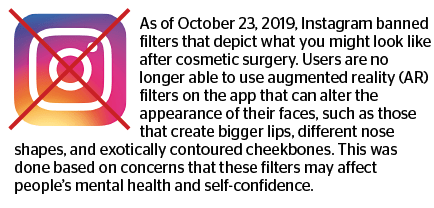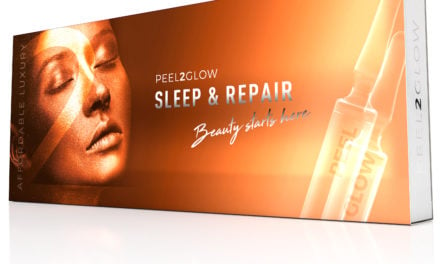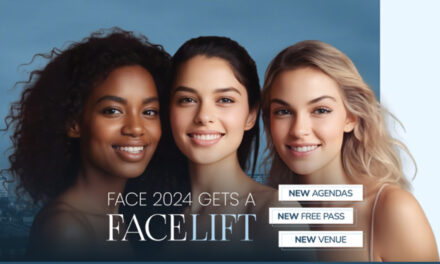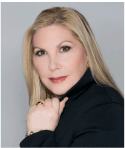
wendy lewis is President of Wendy Lewis & Co Ltd, Global Aesthetics Consultancy, author of 12 books, and Founder/ Editor-in-Chief of www. beautyinthebag.com. Her newest book is Aesthetic Clinic Marketing in the Digital Age (CRC Press 2018) contact [email protected]
Wendy Lewis took a deep dive into how aesthetic practices can survive and flourish by focusing on these emerging demographics while not abandoning their bread and butter patients
As the aesthetics industry continually expands and grows, it has almost become a cliché that millennials and men are the new Holy Grail for medical aesthetics.
But let’s look at the math.
According to the American Society for Aesthetic Plastic Surgery (ASAPS), the most recent statistics from 2018 showed that 20.1% of non-surgical and surgical procedures were undertaken by 18 to 34-year olds in 2018, whereas 37.4% of these procedures were credited to ages 35 to 50, and 29.6% to ages 51 to 64. Furthermore, a reported 7.1% of surgical procedures were attributed to men alongside a mere 7.6% of all non-surgical procedures1.
Nashville, TN facial plastic surgeon Mary Lynn Moran, President of the American Academy of Facial Plastic and Reconstructive Surgery (AAFPRS) reports a definite increase in men seeking treatments; ‘Over the past 5 years, my male patients have increased from 10% to 15%. I am definitely seeing more men under 35. I would say that 10 years ago, I saw more middle-aged men trying to stay relevant in the working world and dating game, and now I am seeing younger men who are more aesthetically oriented and aware of the value of preventative care.” Yet, Dr Moran ranks her patient base in descending order as follows: women 50-60’s, women in their 40’s, followed by women in their 30’s, and men 50-60, followed by men 30-50.
I sought out to take a deeper dive into how these new patient populations approach aesthetics and what their primary goals and concerns tend to be, through the experiences of six busy aesthetic practitioners in different cities.
The millennial mystique
How many times in any given day do you hear the word ‘millennial’ and start to cringe? Well, we can blame Neil Howe and William Strauss for that. These two historians first coined the term in 1991 in their American history book entitled Generations — The History of America’s Future 1584–2069 (Harper Collins). Their premise was that this generation, who were only eight-years-old at the time, would be drastically different than the one before them, so they needed a distinctive name2.
So, who are these Millennials and why should we care?
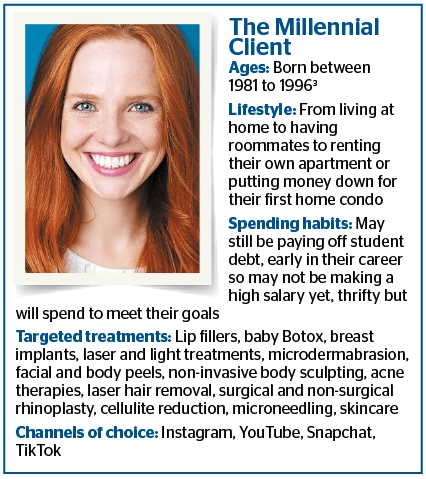
Whereas Baby Boomers grew up as television rose to be the entertainment and information vehicle of choice which fundamentally changed their connection to the world, millennials came of age during the explosion of the Internet which has shaped their mindset.
Millennials are determined not to age as their parents did. As such, they are hard-wired to invest in preventing the ageing process from happening in the first place or at least delaying it as much as they can. The flip side is that they are also into green beauty, CBD oil, sustainable packaging, natural this and that, so toxins and lip injections may seem like a slight departure.
Convenience is a major factor for this active generation when choosing a practitioner, and they will readily compare their experience to other industries, like retailers, malls, and online outlets. The challenge for aesthetic practitioners who want to attract and retain younger patients is how to meet their increasingly high demands and still turn a profit.
Most practitioners report that they are definitely seeing more young and younger patients for a variety of treatments. ‘The younger population has increased by at least 20–30% in my practice, and they are more likely to consider monotherapy than comprehensive treatments for a variety of reasons including cost, downtime, and the fact that most of them do not need much. Popular monotherapy treatments unique to millennials are single area neurotoxins, lip filler injections, or microneedling,’ says Boca Raton, FL oculoplastic surgeon Steven Fagien.
According to dermatologist Stefanie Williams of Eudelo Clinic in London, ‘The visit of a younger patient is very different compared to that of a more mature person. In younger skin, we focus mainly on prevention (including topical high-grade antioxidant serums and SPF30-50), and possibly early intervention (for example if somebody has premature cutaneous sun damage). In more mature skin, it’s much more about correction (such as Botox® for mimic lines and facial contouring for volume deflation), while of course we continue with prevention, as prevention never ends. In addition to corrective treatments, I also always talk about the importance of regenerative treatment such as PRP needling, Exokine® injections, peels, mesotherapy and carboxy facials. This is to rejuvenate the skin on a cellular level, rather than just pumping up lines and wrinkles. The most common requests from these patients at Eudelo are treatments to improve skin quality, texture, including pore size and acne scarring, and irregular pigmentation with specialist peels.’

New York dermatologist Jessica Weiser, M.D. practices in the heart of Soho and sees a lot of younger patients. ‘When younger patients visit my office for a cosmetic consultation, I generally hand them a mirror so they can identify what they see that bothers them, or what they are looking to improve. I find that they often have a specific complaint, such as undereye circles or large pores, so this allows me to open up my dialogue with them. Once I have a take-off point, I can give them options for skincare products and possible in-office treatments to address their concerns. Establishing a rapport with patients is an important first step because it allows them to trust me and then look to me for additional advice and recommendations.’
She continues, ‘In New York City, we see a wide variety of millennials and my office specifically attracts patients who are looking to maintain a natural and understated aesthetic. Patients seeking duck-bill lips generally do not come to my office because I do not provide that type of treatment. The most common treatment I perform on younger patients is neuromodulator injections for furrow lines, early crow’s feet, and forehead lines. I also treat many skin texture and tone concerns such as acne scarring, large pores, sun damage, melasma, and redness/broken capillary blood vessels.’
Reaching millennials where they live
To be visible to savvy younger patients, the main objective is to get busy online on the social channels where they live. Being insta-fabulous has become one of the goals of this age group who are heavily influenced by celebrities and their peers.
According to Dr Moran, ‘We are living in an era of manipulated images and photos that can effortlessly be altered by adding a filter or editing out flaws. The term ‘Selfie Surgery’ was coined after the release of the 2017 AAFPRS Annual Survey4 that reported that 55% of our facial plastic surgeon members had seen an increase of patients seeking surgery in order to look better in their selfies, and it went viral.’
‘One trend that I see being picked up on social media among our younger patients is the desire for completely flawless skin; ‘I want my skin to be perfect, even without make-up’. Skin that has zero irregular pigmentation and virtually invisible pores is a dream that is of course unrealistic. This may be heavily influenced by photo filters being used online,’ says Dr Williams.
Dr Weiser concurs that social media is a prime influence for young patients. ‘With celebrities and influencers never more present or more popular, there is tremendous pressure to pursue aesthetic treatments at younger and younger ages. While some patients seek out dramatic filler injections and physical enhancements, many “millennials” are using this influence to pursue anti-ageing therapies, comprehensive skincare routines, regular sunscreen use, small quantities of neuromodulators, light laser resurfacing and pigment correction, and more in order to maintain their youthful complexions with the intention of preventing or further deferring the need for more invasive treatments later in life,’ she adds.

There is no doubt that younger patients are comfortable choosing and also ruling out doctors from their social media feeds. If they like what they see, they will follow you and engage, so that when they are ready to take the plunge, your practice will be top of mind. It is not uncommon to hear comments like, ‘I felt like I knew them before I ever went to their clinic.’
‘These patients find us on Instagram, RealSelf, Google, YouTube, but also from word-of-mouth and referrals. Instagram, no question, is the biggest driver. It seems like every day I have at least a couple of patients tell me that they follow me on Instagram. It’s the new Yellow Pages for plastic surgeons,’ says Dr Youn.
Indeed, for millennials and Gen Z, Instagram is the new Google. If you are not sufficiently active on Instagram at a minimum, your practice may not be visible to this patient population.
The next frontier: Gen Z
To put it in perspective, Gen Z are often referred to as ‘post-millennials’. They grew up as the computer revolution was taking hold. Falling somewhere between adolescence and adulthood, Gen Z is at a turning point. The oldest members of Gen Z have already graduated from college and are now in their early 20s. They may be in grad school or contemplating it. Because they are known to be living on tight budgets and watching their discretionary spending, they may not have a lot left for facials and light treatments.
Whereas they could be the next big-ticket for medical aesthetics, they’re not quite there yet. However, when these consumers enter the workforce, it may be worthwhile to tap into their purchasing potential. Winning their loyalty may present challenges for aesthetic practices because loyalty to brands and businesses is not in their mindset. For starters, Gen Z’s desire for seamless digital experiences and convenience is not easy to meet for every practice. They are all about enticing in-store experiences and tend to seek out unique products offered by trendy distinctive brands that speak to them. Offering convenient options are critical to winning over the hearts and minds of these young consumers, but they tend to be fickle and will jump from one clinic to another for a great deal.
Gen Z’ers also don’t feel knowledgeable enough to manage their finances and have short credit histories, according to a recent U.S. survey from Experian®. Many Gen Z’ers surveyed say innovative tools are the way to go when it comes to learning about credit (45%), and almost half (48%) would prefer to use tech-driven tools to learn more. According to the survey, this group is learning about finances mostly through their friends (28%), YouTube (27%) and some form of social media (24%). Unfortunately, money and finances cause them a lot of stress and anxiety, and student debt is often a big factor5. The survey also revealed that more than half (51%) of respondents are afraid money issues will stop them from doing the things they want to do in life, 43% are afraid they will not make enough money to be happy, and 37% feel pressured to compete with peers when it comes to money and having nice things.
 Digital drives them
Digital drives them
Flashy social media campaigns resonate with these prospective patients. It is very common for this group to learn about products through social media and execute purchases in-store. Given these consumers’ affinity for all things digital and their habits to go to malls and shops, it helps to come up with ways to blend the online and offline worlds for them. A large portion of this demographic don’t have credit cards yet, so they may be more inclined to use debit cards, or pay vendors via mobile apps, like Venmo and Zelle. If you are keen to attract these patients into your practice, focus on giving them a unique experience with brands and treatments that aren’t available everywhere.
Gen Z was the first generation to be immersed in a digital environment from an early age, starting with video games. Although traditional forms of advertising and promotions are less likely to move them, digital content formats can help drive them into the right kind of practices and deepen ties to your brand.
As they continue to grow in commercial importance, staying on top of their habits can help to ease you into engaging with them effectively. Leveraging creative ways to attract this generation through innovation, such as a clever app, a pop-up store, or enticing event, can help you rise above the noise.
Bro-Tox, Etc.
The notion of men not looking after themselves has been widely debunked as the plethora of successful male-oriented brands and targeted manly marketing campaigns have clearly increased their appetite for aesthetic treatments.
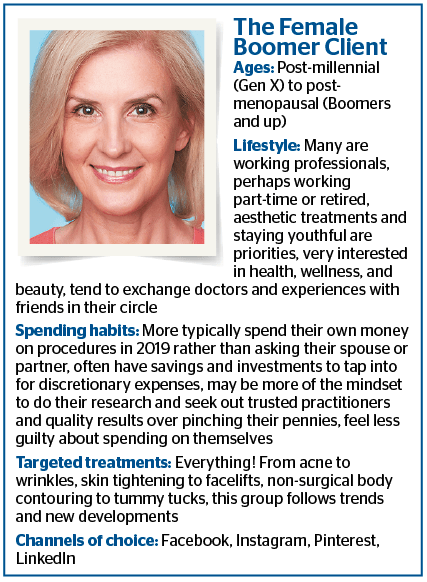
New York City plastic surgeon Sachin Shridharani proclaims that his male practice has at least doubled in the past 5 years. ‘The consultation process with men is very different than that of women. Many men still find there to be a stigma associated with seeking aesthetic treatments. I try to break down that barrier immediately by positioning procedures that less esoteric so that we speak the same language of treatments right from the onset. My male patients also tend to be slightly less informed since this is often very new to them. With that said, they are highly intelligent and ask very insightful questions,’ he says.
He continues, ‘The most requested surgical procedures by men are liposuction and blepharoplasty as excess fullness and/or ageing eyes add years to an otherwise youthful feeling man. The most popular non-surgical procedures are Kybella®, Botox®, dermal fillers, PRP injections to the scalp and our recent addition, CoolTone® for muscle toning.’
If your practice is beginning to attract more men, consider the best approach without overwhelming them with too many options all at once. Dr Fagien explains how he handles the initial consultation. ‘I typically ask men simply, “why are you here?” Knowing more about their motivations can often provide clues to the treatments that they may be willing to undergo. In my practice, lower eyelid bags are a primary concern for men. Although fillers can be an option, my preferred recommendation is usually surgery. I find that most men are less interested in temporary results and are more likely to consider something that has some permanence.’
Dr Moran shares a similar experience with male patients. ‘I have found that men come in with a clear idea of what they want to do. They often don’t have the interest or patience for a complete consultation, including multiple options and areas of potential treatment. They are often ready to book during the first consultation. Whereas, women are more likely to want a more holistic evaluation with a comprehensive plan. Typically, they want to consider all their options and try less invasive options before jumping into a surgical solution.’
In her practice, younger men most often seek treatment for the submental region to improve their jawline, rhinoplasty, and Botox. ‘While men are not as influenced by social media as a group as their female counterparts, they can’t escape it,’ says Dr. Moran.
Neuromodulator and dermal filler injections appear to be the treatment of choice for male patients, and if you position these just right, it can be your gateway to a range of many other male-friendly procedures, including laser hair removal and non-surgical body contouring.
Medical aesthetics: still dominated by female patients
If you’re being honest, adult women with spending power still make up the lion’s share of patients in any practice and for good reason; they are under increasingly more pressure not to age. One major motivating force for having a bit of botulinum toxin, fillers, peels and lasers at frequent intervals is a greater sense of urgency to keep up with their peer group.

The most recent statistics from the American Society of Plastic Surgeons7 (ASPS) showed that two out of three (66%) of all facelifts in 2018 were performed on patients age 55 or older, as well as 48% of all eyelid surgeries. New York City plastic surgeon Alan Matarasso, Immediate Past President of ASPS explains, ‘Our older patients are vibrant and living their lives to the fullest, and they want the way they look to reflect that. Cosmetic procedures among this age group continue to rise year after year.’
And Gen X and boomer females are not just interested in surgery. They are programmed to start earlier to actively slow the ageing process and tend to continue along a path of several forms of intervention through their golden years.
According to Dr. Williams, her clinic attracts a steady flow of female patients for injectables and skin rejuvenation among these sophisticated and well-educated groups. ‘Many of our new female patients come by word of mouth referrals, and not so much via social media. Eudelo resonates most with patients who want a discreet service and natural-looking results rather than the obvious cosmetic work they often observe on others,’ she says.
‘My largest group of patients interested in non-surgical treatments, who make up more than 50% of my practice, are women between 40 and 60. Women over 50 tend to spend more money on treatments as they are typically achievers that not only have the resources for multi-modality treatments but also usually need more to achieve optimum results,’ says Dr Fagien. ‘If you make these patients happy, they will come back again and again to get the results they are looking for, rather than risk shopping around.’
Dr Youn shares a similar experience. ‘Approximately 50% of my practice is women over 40, and 10% is men of all ages. I would estimate that millennials make up about 30%, but they are a much larger percentage of the non-invasive and minimally invasive crowd that we see.’
If you’re wondering what comes after Boomers, the unfortunate term assigned to those born from 1928 – 1945 is the ‘Silent Generation’ (insert frowning face emoji).
In conclusion, time will tell whether the aesthetics industry can successfully entice Gen Z and millennials to morph into the next big spenders. A lot will depend on economic growth and pricing to make treatments more affordable. Personally, I fear that it will remain a challenge to grow the male market to much above 20% globally. However, I may be pleasantly surprised as new developments arise that are longer-lasting, less painful, and have minimal to no downtime, which I believe to be the keys to bringing them on board in greater numbers.
References:
- Cosmetic Surgery National Data Bank Statistics 2018. The American Society for Aesthetic Plastic Surgery. Available at: https://www.surgery.org/sites/default/files/ASAPS-Stats2018_0.pdf [last accessed 28 October 2019]
- Samantha Sharf. What Is A ‘Millennial’ Anyway? Meet The Man Who Coined The Phrase. Forbes online. Aug 24, 2015. Available at: https://www.forbes.com/sites/samanthasharf/2015/08/24/what-is-a-millennial-anyway-meet-the-man-who-coined-the-phrase/#65972fef4a05 [last accessed 28 October 2019]
- Michael Dimock. Defining generations: Where Millennials end and Generation Z begins. Pew Research Center. Jan 17, 2019. Available at: https://www.pewresearch.org/fact-tank/2019/01/17/where-millennials-end-and-generation-z-begins/ [last accessed 28 October 2019]
- Marketwatch. AAFPRS Annual Survey reveals Trends In Facial Plastic Surgery. MarketWatch, Inc. Jan 29, 2018. Available at: https://www.marketwatch.com/press-release/aafprs-annual-survey-reveals-trends-in-facial-plastic-surgery-2018-01-29 [last accessed 28 October 2019]
- Stefan Lembo Stolba. Survey: Generation Z Keen on Learning About Personal Finance and Credit. Experian. Sep 6, 2019. Available at: https://www.experian.com/blogs/ask-experian/survey-generation-z-keen-on-learning-about-personal-finance-and-credit/ [last accessed 28 October 2019]
- Montes JR, Santos E. Evaluation of Men’s Trends and Experiences in Aesthetic Treatment. J Drugs Dermatol 2018; 17(9):941-946
- American Society of Plastic Surgeons. 2018 Plastic Surgery Statistics Report. Available at: https://www.plasticsurgery.org/documents/News/Statistics/2018/plastic-surgery-statistics-full-report-2018.pdf [last accessed 28 October 2019]



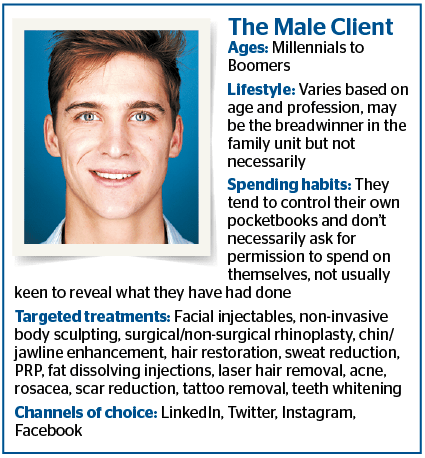 Digital drives them
Digital drives them